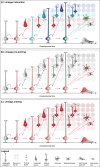Epigenetic cues modulating the generation of cell-type diversity in the cerebral cortex
- PMID: 30276807
- PMCID: PMC6587822
- DOI: 10.1111/jnc.14601
Epigenetic cues modulating the generation of cell-type diversity in the cerebral cortex
Abstract
The cerebral cortex is composed of a large variety of distinct cell-types including projection neurons, interneurons, and glial cells which emerge from distinct neural stem cell lineages. The vast majority of cortical projection neurons and certain classes of glial cells are generated by radial glial progenitor cells in a highly orchestrated manner. Recent studies employing single cell analysis and clonal lineage tracing suggest that neural stem cell and radial glial progenitor lineage progression are regulated in a profound deterministic manner. In this review we focus on recent advances based mainly on correlative phenotypic data emerging from functional genetic studies in mice. We establish hypotheses to test in future research and outline a conceptual framework how epigenetic cues modulate the generation of cell-type diversity during cortical development.
Keywords: cell-type diversity; cerebral cortex; gliogenesis; lineage progression; neurogenesis; radial glial progenitor cells.
© 2018 The Authors. Journal of Neurochemistry published by John Wiley & Sons Ltd on behalf of International Society for Neurochemistry.
Figures


Similar articles
-
Mechanisms of radial glia progenitor cell lineage progression.FEBS Lett. 2017 Dec;591(24):3993-4008. doi: 10.1002/1873-3468.12906. Epub 2017 Nov 22. FEBS Lett. 2017. PMID: 29121403 Free PMC article. Review.
-
Dicer is required for neural stem cell multipotency and lineage progression during cerebral cortex development.Neural Dev. 2013 Jul 29;8:14. doi: 10.1186/1749-8104-8-14. Neural Dev. 2013. PMID: 23895693 Free PMC article.
-
Development and Functional Diversification of Cortical Interneurons.Neuron. 2018 Oct 24;100(2):294-313. doi: 10.1016/j.neuron.2018.10.009. Neuron. 2018. PMID: 30359598 Free PMC article. Review.
-
Principles of neural stem cell lineage progression: Insights from developing cerebral cortex.Curr Opin Neurobiol. 2023 Apr;79:102695. doi: 10.1016/j.conb.2023.102695. Epub 2023 Feb 24. Curr Opin Neurobiol. 2023. PMID: 36842274 Review.
-
Cerebral cortex development: an outside-in perspective.FEBS Lett. 2017 Dec;591(24):3978-3992. doi: 10.1002/1873-3468.12924. Epub 2017 Dec 14. FEBS Lett. 2017. PMID: 29194577 Review.
Cited by
-
Chromatin Remodeling in the Brain-a NuRDevelopmental Odyssey.Int J Mol Sci. 2021 Apr 30;22(9):4768. doi: 10.3390/ijms22094768. Int J Mol Sci. 2021. PMID: 33946340 Free PMC article. Review.
-
Brain-gut-brain axis, nutrition, and autism spectrum disorders: a review.Transl Pediatr. 2024 Sep 30;13(9):1652-1670. doi: 10.21037/tp-24-182. Epub 2024 Sep 20. Transl Pediatr. 2024. PMID: 39399706 Free PMC article. Review.
-
Tissue-wide genetic and cellular landscape shapes the execution of sequential PRC2 functions in neural stem cell lineage progression.Sci Adv. 2022 Nov 4;8(44):eabq1263. doi: 10.1126/sciadv.abq1263. Epub 2022 Nov 2. Sci Adv. 2022. PMID: 36322669 Free PMC article.
-
Transcriptional network orchestrating regional patterning of cortical progenitors.Proc Natl Acad Sci U S A. 2021 Dec 21;118(51):e2024795118. doi: 10.1073/pnas.2024795118. Proc Natl Acad Sci U S A. 2021. PMID: 34921112 Free PMC article.
-
The emerging role of chromatin remodelers in neurodevelopmental disorders: a developmental perspective.Cell Mol Life Sci. 2021 Mar;78(6):2517-2563. doi: 10.1007/s00018-020-03714-5. Epub 2020 Dec 2. Cell Mol Life Sci. 2021. PMID: 33263776 Free PMC article. Review.
References
-
- Alcamo E. A., Chirivella L., Dautzenberg M., Dobreva G., Farinas I., Grosschedl R. and McConnell S. K. (2008) Satb2 regulates callosal projection neuron identity in the developing cerebral cortex. Neuron 57, 364–377. - PubMed
-
- Angevine J. B. and Sidman R. L. (1961) Autoradiographic study of cell migration during histogenesis of cerebral cortex in the mouse. Nature 192, 766–768. - PubMed
Publication types
MeSH terms
Grants and funding
LinkOut - more resources
Full Text Sources

